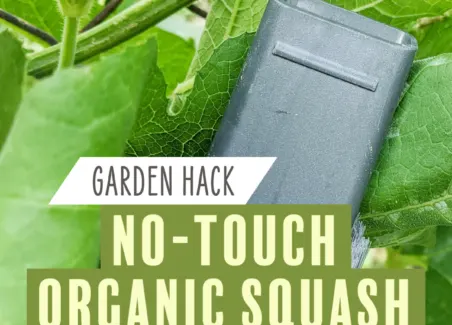If my blog had a category called “things that look dumb but actually work,” this post would definitely be under that heading. See, squash bugs gross me out, like really gross me out, so controlling squash bugs on my pumpkin and zucchini plants is especially challenging.
This past year, as I set up a makeshift garden after moving to Hawk Hill Cottage in the spring I definitely let the squash bugs have free rein of my cucurbits (squash and pumpkin family) and I paid the price. Suddenly, it was August first and I hadn’t harvested a single zucchini from my 4-foot wide plant!
My pumpkin, which was gleefully spanning a chain-link fence, and for which I was ready to try my method for growing watermelons vertically, hadn’t set a single pumpkin. It was obvious from examining these plants that the angular black and gray creatures I knew to be squash bugs were terrorizing my squash beyond what my plants could handle.

I’m an organic gardener, which means that bugs in my garden feel expected. At least to some degree, I usually just let them do their thing and hope that I’ve planted sufficiently, or have healthy enough plants, that there will be food enough for both my family and the bugs that call my garden home. In the case of the squash bugs, especially this year, that was clearly not the case. Squash bugs were overrunning my plants, with big squash bugs breeding in broad daylight, eggs clusters on most leaves, and tiny neophyte nymphs crawling everywhere like tiny spiders.
Enough was enough, and when I did plant-surgery to remove the other summer squash pest – squash vine borers- from my squash plants, I realized there were so many squash bugs that my plants were never going to produce fruit. Since it was my first time gardening since I moved back from urban Seattle, I decided I would do what it took to get rid of the squash bugs and take back my squash plants. (Well, I was willing to do anything except, you know, touch a squash bug.)
At the same time, I was working on my built-in Pax wardrobe in my dressing room, and one day as I was shop vacuuming up sawdust from that project, I had an idea: Could I use a vacuum to suck up adult squash bugs, eggs, and these tiny insect pests? I turned to Google to see if anyone had tried a similar approach and didn’t find anyone discussing this method. Instead, recommendations for dealing with squash bugs were limited to neem oil, using duct tape to lift eggs from leaves, and picking the bugs off (eww!) and dropping them in soapy water spiked with dish soap.
[Click here to learn about the squash bug lifecycle from the UMN extension site.]
The following section may contain affiliate links. As an Amazon Associate, we earn from qualifying purchases.
My hands-free method for getting rid of squash bugs
I knew a standard vacuum or shop vac would probably be too powerful (and too much trouble) to work well to rid squash bugs from my garden. I didn’t want to risk damaging the leaves of my plants with too much suction and I didn’t want to deal with extension cords and running electricity out to my squash patch. So instead, I took to Amazon and it was there that I found Bissell’s AeroSlim pint-sized handheld vacuum. The price was right and I knew that I would use it for countless other purposes around the house so I took the plunge and ordered this small vacuum so I could experiment with vacuuming up squash bugs right off the plants without ever having to touch them.
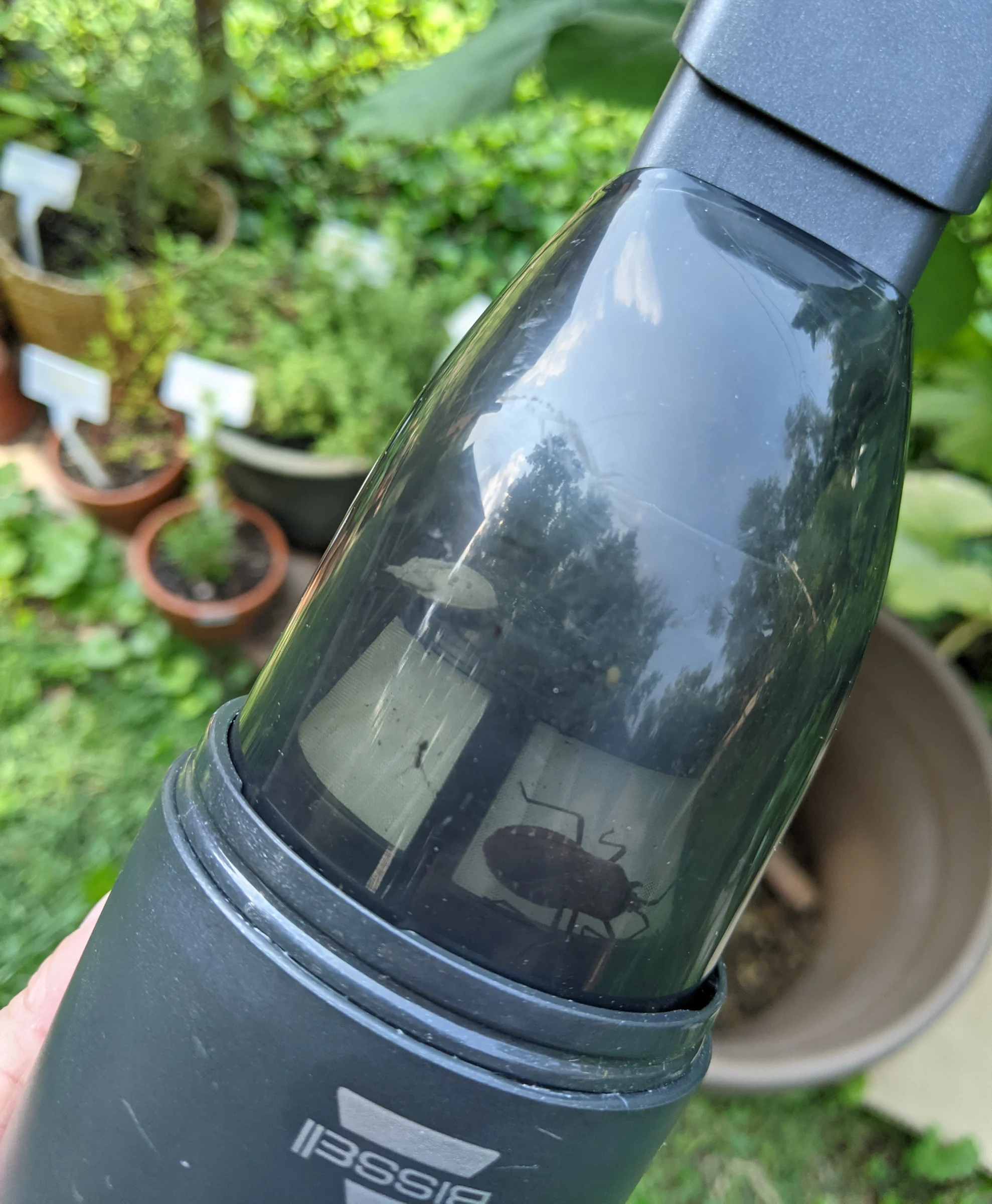
Why the Bissell AeroSlim is perfect
As I carefully read the reviews on potential handheld vacuums to use for getting rid of squash bugs naturally, I was actually drawn to the negative reviews that indicated a particular handheld vacuum had “weak suction.” Weaker section, I hoped, might allow me to slurp up those nasty squash bugs and trap them in the vacuum’s chamber without damaging the plant or sucking leaves into the vacuum and crushing plant cells.
The Bissell vacuum, which is about the size of two Coke cans stacked on top of each other, seemed to be perfect. Small enough to be easy to take out to the garden, and suction just strong enough to pull in full-size squash bugs without damaging the leaves.
How to use a handheld vacuum to control squash bugs organically:
What you’ll need:
- Bissell’s AeroSlim Handheld Vacuum
- a bucket with 1 to 3 inches of water
- Dawn dish soap
- gardening gloves
Start by vacuuming up visible squash bugs
If you’ve got an infestation on your squash plants in your garden, they’re probably visible as you stand nearby. Turn on the handheld vacuum, attach the extension which gives you a little finer control, and begin sucking those bad boys right into the vacuum chamber. Without having to touch them, you’ll be able to trap squash bugs in the vacuum chamber to be dumped into the bucket of soapy water.
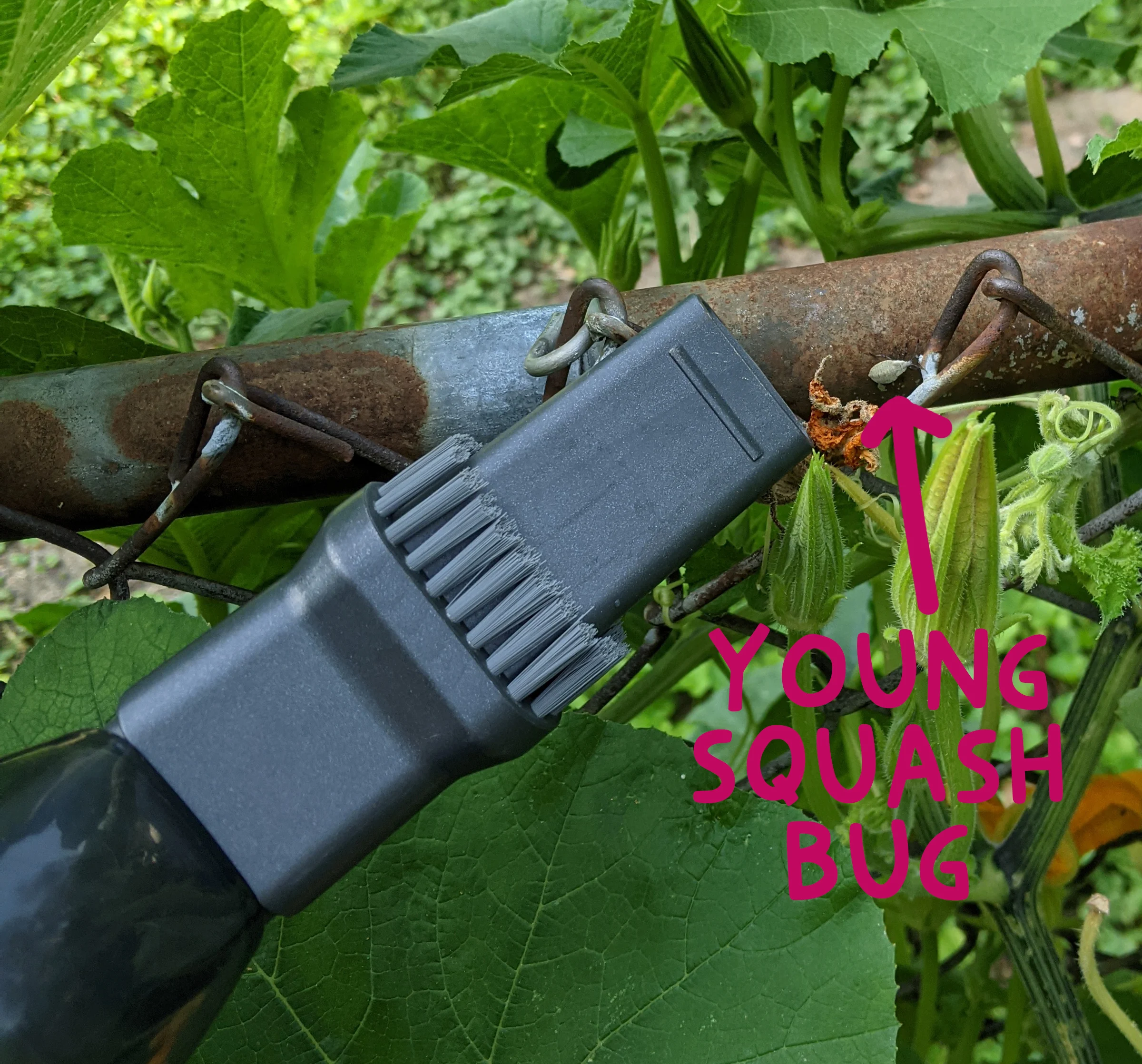
Check leaf undersides for hiding squash bugs
Squash bugs will probably hide as soon as you begin disrupting the plant, so use your gloved hand to lift and ruffle your squash or pumpkin leaves to discover even more squash bugs hiding. Suck them up in the vacuum too.
Empty vacuum chamber into soapy water
Working over your bucket of soapy water, and keeping a firm grip on both parts of the vacuum to prevent dropping it into the water, open the vacuum chamber by twisting the cap off and dump the rising squash bugs into the bucket of soapy water. Tap the vacuum a few times on the rim of the bucket to be sure that all bugs have fallen out of the chamber.
Vacuum up egg clusters
Now that you’ve vacuumed up the most obvious of the bugs on your plants, it’s time to go after the eggs they’ve left behind. Squash bugs lay a ton of eggs – they look like clusters of metallic beads on the undersides of squash and pumpkin vines. You can use your handheld vacuum’s tip to scrape these eggs off the leaf and let the suction draw the eggs into the chamber, or you can use your gloved hand to tear off a small section of the leaf where the eggs are attached and feed that small portion of leaf to the suction of the vacuum.
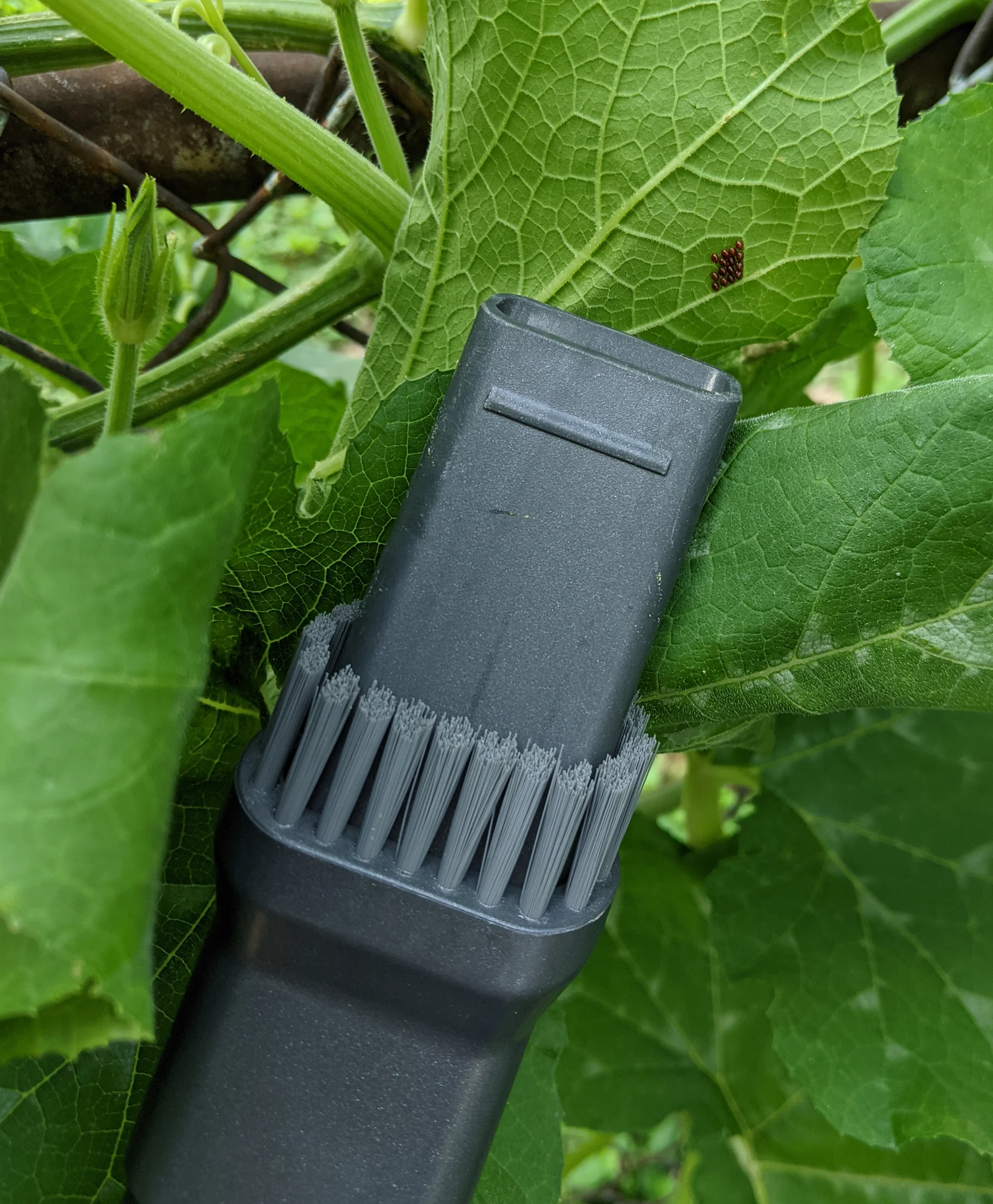
Empty squash bug egg clusters into soapy water
The last thing you want is squash bugs hatching in your handheld vacuum (oh my gosh! I don’t even want to imagine this!) So after you’ve sucked up all the eggs you can find, be sure and thoroughly empty the squash bug eggs from your vacuum into the soapy water.
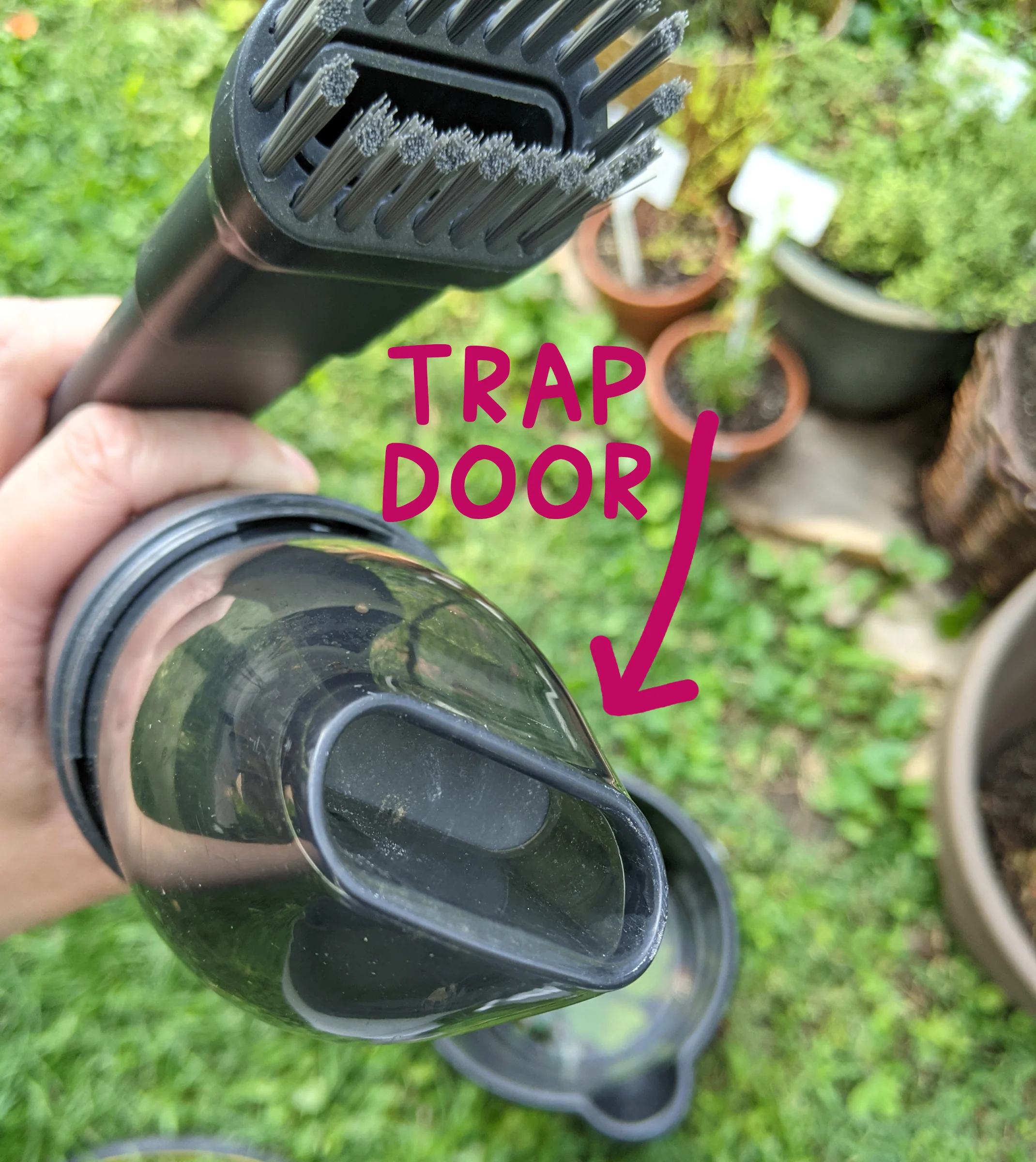
Next, spray the squash plants with water
Squash bugs hate water, so when the plant and the ground around it get wet, the squash bugs begin to climb for higher ground. If you take a moment to spray down your squash plants, you’ll find that more of these pests will climb out from their hiding places and began crawling over the stems and leaves. Use your vacuum to suck up these stray pests, being careful not to suck liquid into your handheld vacuum.

Empty and clean your bug-sucking handheld vacuum
Empty any last captured bugs into your bucket of soapy water. Wait 5 to 10 minutes, and then dump your bucket into a sewer drain (do not dump soapy water into a storm drain- the surfactants in soap mean that the water needs to be processed in a water processing plant before it is safe to enter a water stream). Then, disconnect the clear part of the handheld vacuum and wash it and the extension piece under running water to be sure that no tiny nymphs or eggs remain in the vacuum parts.
Final Thoughts
That’s it! Controlling squash bugs using a handheld vacuum is really easy, once you follow these steps to do the first squash bug purge in your garden, you’ll probably need to repeat a few more times to the season – but with consistency in removing the eggs, you should never have quite as many bugs to vacuum up on subsequent visits to your squash patch.
This method works great for me and my tiny garden, if you tried it I love to hear how it worked for you – drop me a comment below.

